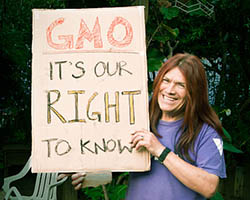Are Transgenic Plants Safe to Eat?

Some people believe that transgenic plants (also called GMOs) that are made in a lab are unsafe to eat because they are unnatural. This isn’t a good way to decide what is safe to eat because there are many natural things which are unsafe to eat. For example, poisonous plants and dangerous viruses are natural but can make us very sick.
If a transgenic plant is going to be sold as food, the federal government requires companies to test the plant’s safety first. Even after the plant is approved by the government, many other scientists also study the plant on their own to verify if it is safe or not.
There have been over 2,000 studies done by many different scientists to see if transgenic plants are harmful to animals or the environment. One group of scientists reviewed data from over 1,000 studies and concluded there is no evidence that transgenic plants are unsafe to eat.

They also found that the plants did not cause harm to the environment, but that the plants enabled farmers to decrease the use of highly toxic pesticides.
But many people still believe transgenic plants are unsafe. Sometimes, this is simply because they don’t understand how genetic modification works and that can be scary. Other times, it is because it can be difficult to determine what information you can trust.
What Information Can You Trust?
There are a few tips you can follow to decide whether or not a paper can be trusted. First of all, you want to make sure that the study is published in a science journal. For published articles, you can use a trusted search engine such as PubMed or the Web of Science. You can also check what companies or schools the authors are associated with to make sure it is somewhere legitimate research is usually done.
If you find a study of interest, you can try reading it to see if the study is well-designed. You can check to make sure the study had reasonable controls (a non-tested group) as well as groups that were given reasonable treatments (what was being tested). The experiment should be tested using several different individuals, locations, animals, or whatever the subject of interest is. Every method used should also be discussed so that someone else could complete the study.
If you don't trust yourself to judge the science in an article, there is another trick you can use. You can look into the quality of the journal in which the article is published. Most legitimate journals have a measure that we call an impact factor. The impact factor tells you how many times a paper from that journal has been mentioned in other published papers (this act is called "citing" a paper) over a specific time period.
Sometimes, publications based on bad science can still slip through the cracks and wind up in a respectable journal or getting cited. But usually, the rest of the scientific community will catch these mistakes fairly quickly and published studies can be retracted, meaning the journal removes the article from publication.

So how does this all currently measure up in the world of transgenic crops? No legitimate evidence has shown that transgenic crops are harmful to humans. There is also no strong scientific hypothesis, or reason, why the currently available transgenic plants would be unsafe.
How would taking a gene from a harmless type of bacteria and putting it into corn make the corn unsafe? Why would taking a gene from a potato and putting it into a different potato make it inedible? Why would changing one or two specific genes in a species be more dangerous than hybridizing two species and changing thousands of genes in the process?
There is no scientific reason why this would be unsafe, but even so, scientists are constantly testing transgenic and non-transgenic foods to see how they affect human, animal, and environmental health.
Images via Wikimedia Commons. Cotton image by Michael Bass-Deschenes.
Read more about: What's a GMO?
Bibliographic details:
- Article: Safety of GMOs
- Author(s): Dr. Biology
- Publisher: Arizona State University School of Life Sciences Ask A Biologist
- Site name: ASU - Ask A Biologist
- Date published:
- Date accessed:
- Link: https://askabiologist.asu.edu/safety-gmos
APA Style
Dr. Biology. (). Safety of GMOs. ASU - Ask A Biologist. Retrieved from https://askabiologist.asu.edu/safety-gmos
Chicago Manual of Style
Dr. Biology. "Safety of GMOs". ASU - Ask A Biologist. . https://askabiologist.asu.edu/safety-gmos
Dr. Biology. "Safety of GMOs". ASU - Ask A Biologist. . ASU - Ask A Biologist, Web. https://askabiologist.asu.edu/safety-gmos
MLA 2017 Style

Transgenic cotton is modified to resist insect pests. This makes it so farmers don't need to use as many pesticides.
Be Part of
Ask A Biologist
By volunteering, or simply sending us feedback on the site. Scientists, teachers, writers, illustrators, and translators are all important to the program. If you are interested in helping with the website we have a Volunteers page to get the process started.

